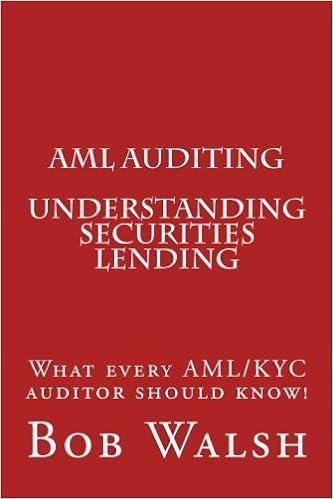Question
The following are the Cool Company's projected unit costs at a normal level of 20,000 units per month . These costs are approximately the same
The following are the Cool Company's projected unit costs at a normal level of 20,000 units per month. These costs are approximately the same as for the prior year. Sales are expected to be uniform throughout the year, therefore annual volume is projected to be 240,000 units. Assume their fiscal year ends on December 31.
Manufacturing costs:
Variable direct cost (materials & labor) $ .60
Variable manufacturing overhead 3.00
Fixed overhead cost .75
Selling and other costs:
Variable (shipping) 1.50
Fixed 2.00
The following independent situations refer only to the data given above; there is no connection between the situations except where explicitly stated. Unless stated otherwise, assume a regular selling price of $8.50 per unit. Income tax considerations are to be ignored. You should also assume that units are not produced until they are needed for sales (unless specifically indicated otherwise) a pure JIT approach.
REQUIRED: Determine the answer to each of the following situations. Support each answer with summarized computations and a list of any assumptions on which they are based. If you foresee any significant qualitative factors in any of the situations described below, clearly identify them.
1. What would be the conventional GAAP unit cost used to value an inventory of these products on the balance sheet of the company?
2. What unit cost would be relevant to setting a normal selling price for this product, assuming that the implied level of annual operations is to be maintained?
Assuming that 20,000 units are produced and sold each month, what is the annual breakeven point (in units)?
3. Assume it is December 1 and sales to date total 220,000 units. Our marketing department projects December sales will be 15,000 units. A proposed contract is received from a government agency for 5,000 units of our product and calls for the reimbursement of all costs of manufacturing plus a fixed fee of $4,000. In addition, the government would pick up the products from our plant, and the total fixed selling costs would be reduced by $2,000. No other buyer exists for these 5,000 units. Should this contract be accepted?
4. Assume the same data as in No. 4 except that the marketing department is projecting December sales of 20,000 units. If we accept the government contract, it would prevent the sale of these 5,000 units through regular channels at the normal selling price. Should the government contract be accepted?
HINT: For Nos. 3 & 4, DO NOT PREPARE COMPLETE INCOME STATEMENTS focus on only the relevant items!
5. The company desires to enter a foreign market, in which price competition is keen. A bid has been requested from Coaster for 10,000 units of our product at the lowest possible unitprice. Because of different packaging requirements in the other country, it is expected that variable selling costs for this order will change to $.85 per unit, and a tariff of $18,000 (total cost for the 10,000 units) will be charged. Assume that we have the capacity to meet the order and domestic business will be unaffected. What is the minimum unit selling price we can quote for this order?
* SEE NOTE BELOW
6. At the beginning of the year, the company has an inventory of 1,000 units of this item left over from last year's model. These units are obsolete and therefore cannot be sold at the regular price. However, they must be sold through Coaster's normal distribution channels. What is the minimum unit selling price for these items?
* SEE NOTE BELOW
7. A proposal is received from an outside supplier who will make and ship this item directly to Coaster's customers as sales orders are forwarded from our sales staff. Coaster's total fixed selling costs will be unaffected, but its variable selling costs will be slashed by 85%. Coaster's plant will be idle, but its total fixed manufacturing overhead would continue at 20% of present levels. What unit cost should the company use to compare with the quotation received from the supplier?
8. Assume the same facts as in No. 7 except that if the supplier's offer is accepted, the present plant facilities will be used to make a product whose unit costs will be:
Variable manufacturing costs $4.25
Fixed manufacturing costs .60
Variable selling costs 2.00
Fixed selling costs .40
Since the new product will be produced in the existing facilities, total fixed factory overhead incurred in the present plant will be unchanged, and total fixed selling costs will remain the same (the amount shown for the new product represents an allocation of the total cost). The new product will sell for $9.00 per unit. The total minimum desired net profit on the two products taken together is $500,000 per year.
What is the maximum purchase cost per unit that the Class Company would be willing to pay for subcontracting the old production?
* SEE NOTE BELOW
* NOTE: In the questions referenced to this note, Coaster would not necessarily sell at these minimum prices or pay these maximum prices, but they would provide us with a frame of reference for negotiation!
Step by Step Solution
There are 3 Steps involved in it
Step: 1

Get Instant Access to Expert-Tailored Solutions
See step-by-step solutions with expert insights and AI powered tools for academic success
Step: 2

Step: 3

Ace Your Homework with AI
Get the answers you need in no time with our AI-driven, step-by-step assistance
Get Started


